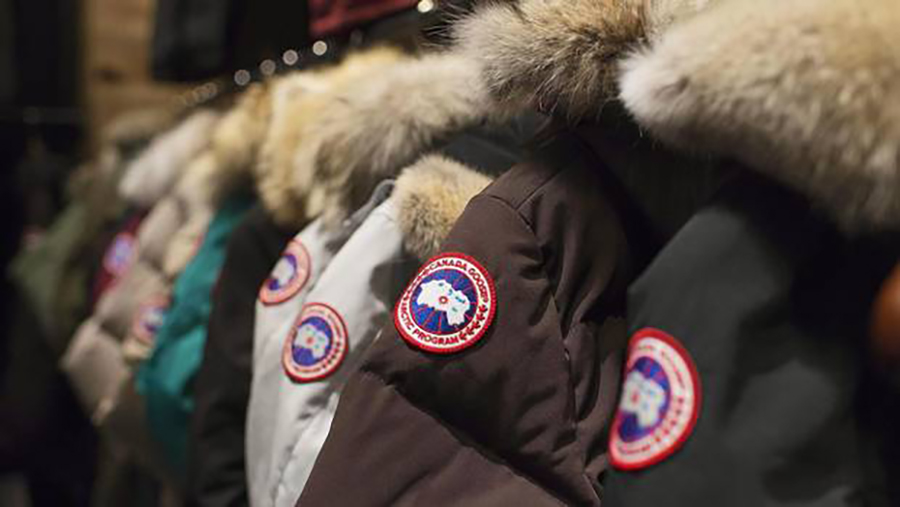By Eric Smith
Shares of Canada Goose Holdings Inc. tumbled $15.28, or 31.2 percent, to $33.74 Wednesday after the company earlier in the day reported a fourth-quarter revenue miss—its slowest revenue growth in eight quarters—plus lower-than-expected guidance for the current fiscal year.
Canada Goose’s fiscal fourth-quarter revenue did improve 25 percent to $156.2 million, but that still fell shy of analysts’ consensus estimates of $156.8 million (all figures are in Canadian dollars).
And despite the company’s eye-popping revenue surge of late, including a 40.5 percent increase in 2019, Canada Goose now expects slower growth of around 20 percent for fiscal 2020. The company also projects an especially tough first quarter, all of which prompted investors, especially short sellers, to react negatively Wednesday.
According to a Bloomberg report using data from the firm S3 Partners, “almost 8.3 million Canada Goose shares are held by short sellers, or 14.13 percent of float, representing $406 million.”
Bloomberg quoted Ihor Dusaniwsky, head of research for S3, as saying, “There is ample stock loan availability in Canada Goose so there is no fear of a technical short squeeze in the stock due to excessive stock borrow fees or recalls.”
The article continued that Dusaniwsky “expects to see additional short selling on the stock as bears are now in the black and the shares have been trending downwards for the last month. This would be especially true if the stock price continues trending toward the $30 level.”
Prior to the stock tanking on Wall Street, Canada Goose executives were upbeat about the company’s fiscal Q4 and full-year performance. And on the surface, there was cause for excitement.
“We entered this year with a very ambitious growth agenda, our biggest ever, and we have surpassed it with flying colors,” President and CEO Dani Reiss said on Wednesday morning’s earnings call with analysts. “We accomplished in a single year at Canada Goose what often would be five or 10 years at many other companies. Fiscal 2019 was no different. We have made massive progress against all of our key initiatives.”
At the same time, the company has encountered some cost increases. Not only is Canada Goose expanding its retail and direct-to-consumer business, but it’s also growing rapidly in new global markets, notably China.
“I think the DTC expansion is something that will affect the shape of our numbers in the context of the growth trajectory that we’re on,” CFO Jonathan Sinclair said. “You will see a significantly higher proportion of revenue and profit in the back half of the year and that means both in Q3 and ultimately in Q4, but particularly Q3, which is the key quarter. That will also manifest itself in materially larger losses in Q1, and when you think about that, we’re also activating markets, and investing behind the middle marketing sense, both at the time of launch and the head of that launch. And so those investments are also happening ahead of the realization of the revenue. So you put those two together and that’s what brings more weight to bear in the first quarter.”
Looking deeper into Canada Goose’s fiscal fourth-quarter performance, adjusted net income was flat at $10 million, or 9 cents a share. Net income was $9 million, or 8 cents a share, up one cent from a year ago. Adjusted EBITDA declined 6.4 percent to $20.4 million, and reported EBITDA of $19.1 million was down slightly.
Read more about Canada Goose’s Q4 earnings here.
For fiscal 2020, the company currently now expects the annual revenue growth of at least 20 percent, adjusted EBIT margin expansion of at least 40 basis points and annual growth in adjusted net income per diluted share of at least 25 percent.
And over the next three fiscal years, the company currently expects average annual revenue growth of at least 20 percent; annual adjusted EBIT margin expansion of at least 100 basis points in fiscal 2022, relative to fiscal 2019; and average annual growth in adjusted net income per diluted share of at least 25 percent.
Canada Goose said the long-term outlook assumes, among other things, a continuation of current economic conditions and execution of the company’s ongoing growth strategies.
Photo courtesy Canada Goose
[author] [author_image timthumb=’on’]https://s.gravatar.com/avatar/dec6c8d990a5a173d9ae43e334e44145?s=80[/author_image] [author_info]Eric Smith is Senior Business Editor at SGB Media. Reach him at eric@sgbonline.com or 303-578-7008. Follow on Twitter or connect on LinkedIn.[/author_info] [/author]
















